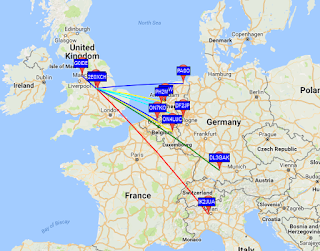Well,
I think I have finished the build of the VLNA for 13cm; having constructed the project I am wishing I had bought a ready built and aligned unit. This was the hardest project to date, mainly because of the very tiny components. I really struggled to get the input matching network parts in place - and have no test gear to actually measure the return loss or noise figures of the final build.
It looks like this:
You can see the input network components in the image above; it kind of looks like the instructions from G4DDK @DXING, but I have no means to actualy measure or test the input return loss.
Lets see.
I think I have finished the build of the VLNA for 13cm; having constructed the project I am wishing I had bought a ready built and aligned unit. This was the hardest project to date, mainly because of the very tiny components. I really struggled to get the input matching network parts in place - and have no test gear to actually measure the return loss or noise figures of the final build.
It looks like this:
You can see the input network components in the image above; it kind of looks like the instructions from G4DDK @DXING, but I have no means to actualy measure or test the input return loss.
Lets see.






















































